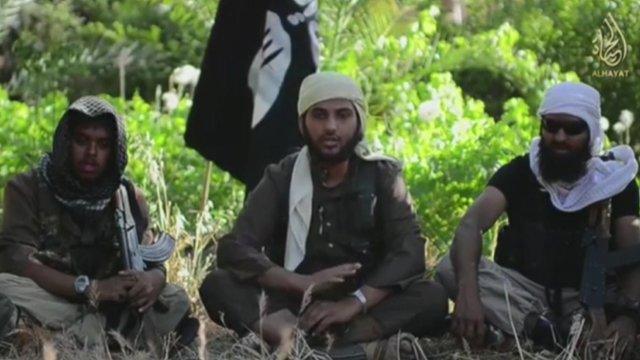The social media life of a Malaysian jihadist
- Published
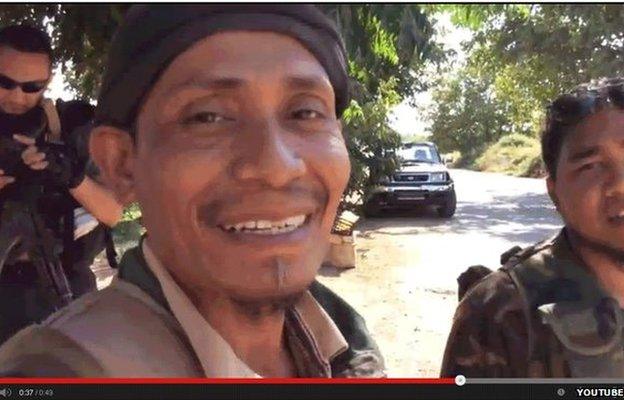
Malaysian jihadists believed to be fighting in Syria have gained formidable notoriety on social media
There is growing concern in South East Asia and Australia over nationals fighting with Islamist groups in the Middle East. Australia is planning laws to block fighters from conflict zones and Indonesia has banned the ideology of the Islamic State, the Islamist militant group which has overrun areas in Iraq and Syria.
In Malaysia, which believes a small number of its citizens are fighting overseas, officials are monitoring the online activity of suspected militants. At home arrests have been made of people planning to travel to fight, police say, and the home minister says when Malaysian fighters return they will be arrested and charged. But amid mounting awareness of how these fighters are using social media to preach and recruit, BBC Monitoring looks at the online activity of a group of Malaysians claiming to be in Syria.
They are online every few days, posting images and videos of life in Syria: posing with AK-74s and tanks; celebrating Eid with spiced meat and coffee from home; and answering questions from the interested.
Ahmad Salman Abdul Rahim and Mohd Lotfi Ariffin are two of a group of Malaysians in Syria who say they are engaged in jihad, fighting against Bashar al-Assad.
According to their Facebook accounts, they are based in the city of Hama, and they claim to be members of Ajnad al-Sham, which they say is loosely linked to the al-Nusra Front. They disavow any links to the Islamic State in Iraq and the Levant (Isis), now called the Islamic State.

Al-Nusra Front
Led by Abu Mohammad al-Julani and aims to establish an Islamist state in Syria
Has some 5,000 official members, supported by thousands of others, and apparently has members inside government and military
Launches big guerrilla attacks on rural government targets and lower level urban attacks, using car bombings, suicide attacks, targets media facilities and personalities

The two men have such a presence on social media that a number of Malaysian news outlets have interviewed them through Facebook. Their posts explain and glorify what they see as a religious mission but also document its banalities.
In a picture posted during Ramadan, Ahmad Salman stands with one foot on a headless body, sunglasses on and a rifle in each hand. But the picture is overwritten with the words "penyakit riak" - the disease of conceit.
Contrary to his victorious pose, its caption explains that he has posted it to remind himself to act sincerely, rather than to attract adulation, and piously quotes the Koran and Islamic teachings.
Amid sympathetic comments, one from a doe-eyed girl addressing him as "uncle" wishes him well and asks: "What time do you break your fast over there?"
The picture was liked more than 1,300 times, and responses to this and other posts are mostly positive - a source of worry to Malaysian authorities and experts, who say using social media is one of the ways in which groups in the Middle East are radicalising and recruiting fighters.
Social media's lure
Syria says 15 Malaysians have been killed in fighting there so far. The Malaysian government says it has not confirmed this but believes at least 30 Malaysians are fighting in Syria. A suicide bomber who killed 25 policemen in Iraq in May is also thought to have been Malaysian.
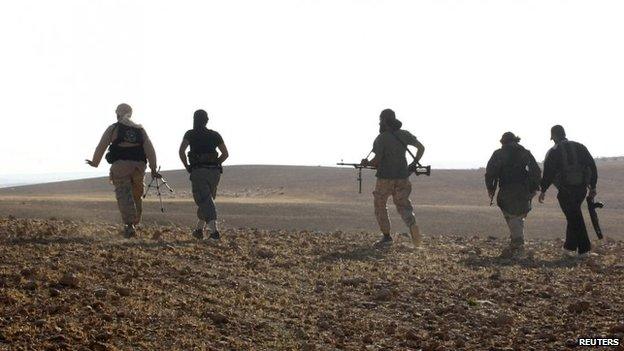
Some of the Malaysian fighters attracting attention on Facebook say they are fighting in Hama, Syria
At home, police have arrested at least 16 suspected militants since April and say they are keeping a close eye on sites recruiting to jihadist causes.
But the Facebook pages of Ahmad Salman, Mohd Lotfi and others fighting with the group appear little affected and clearly have an interested audience. Mohd Lotfi has at least four Facebook accounts with almost 60,000 followers or likes between them.
One of the newest fighters to join the group, 21-year-old Mohammad Fadhlan Shahidi, says he was intrigued by Lotfi's Facebook posts and messaged him to ask how he could become a fighter. In a video on his Facebook page, dated 15 May, which has since been removed, he said he was told to make his way to Istanbul with RM6,000 (£1,113), eventually joining the group in Hama.
Another Malaysian fighter frequently seen in photographs and videos posted by Messrs Salman and Lotfi manages a Facebook page with almost 3,000 followers under the name "Akel Zainal".
"Early in the first month I used FB to communicate with just family and close friends... ", he explains in one post. "After Ust [short for ustad, or cleric] Lotfi arrived in the third month, I watched him FB and I saw he had a positive impact proselytising, so I said why not."
Media savvy and mortality
Ahmad Salman appears the most media-savvy of the group. His pictures frequently have filters applied to enhance them and he poses artfully in them, perched casually on the gun barrel of a tank, sitting cross-legged with a knife drawn.

Abu Khattab is the latest Malaysian jihadist to talk about his "religious mission" in Syria on social media
A separate Facebook account called Jelajah Jalinan Bumi Syam - A Tour of the Syrian Lands - is filled with photos of his travels on the way to Syria, and has gained more than 4,000 likes since it was started in May. In his videos, he frequently narrates what is going on and interviews his fellow jihadists as if he were presenting a travel show.
He is also surprisingly free with information, such as his point of entry into Syria - the Bab al-Hawa border crossing - and the group's various purported locations on their journey to Hama.
Now that they have begun taking part in the fighting in Hama, some seem to be starting to appreciate the implications of their jihad, with mentions of the deaths of fellow fighters and, in the case of one calling himself Abu Khattab Malayziya, recording the pain of being shot in the arm, and having to take a badly injured group member to hospital.
Nonetheless, Abu Khattab's latest posts, of his friend's and his own injuries, have been liked several hundred times.
BBC Monitoring, external reports and analyses news from TV, radio, web and print media around the world. For more reports from BBC Monitoring, click here. You can follow BBC Monitoring on Twitter , externaland Facebook, external.
- Published11 July 2014
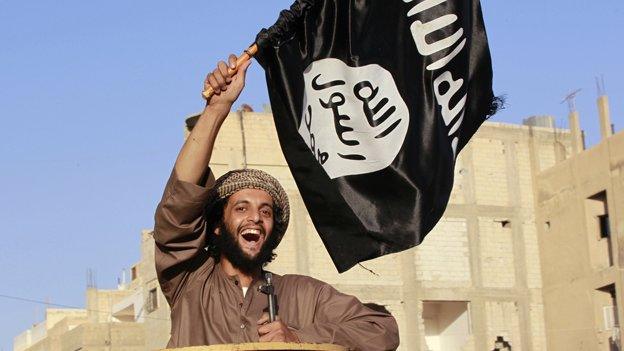
- Published22 July 2014
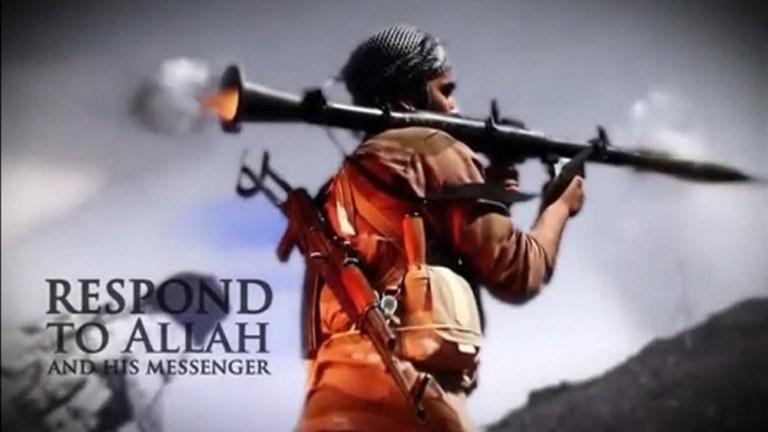
- Published11 August 2014
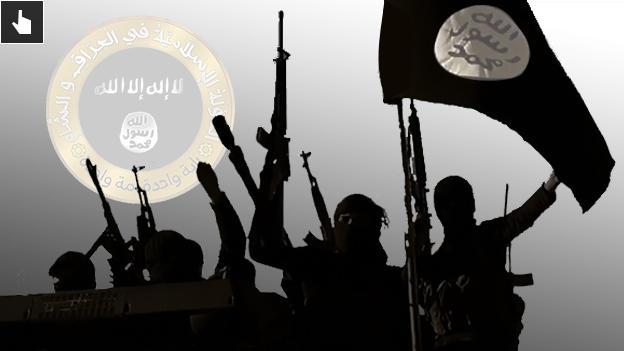
- Published11 August 2014
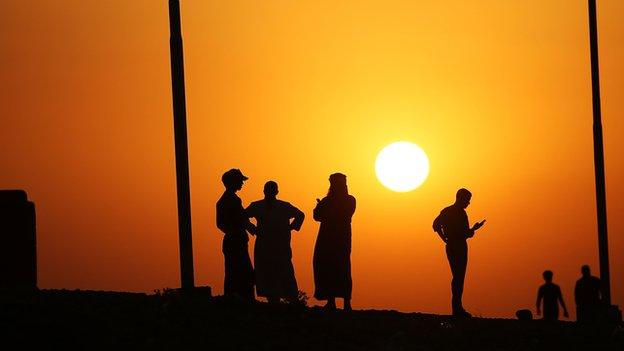
- Published6 August 2014
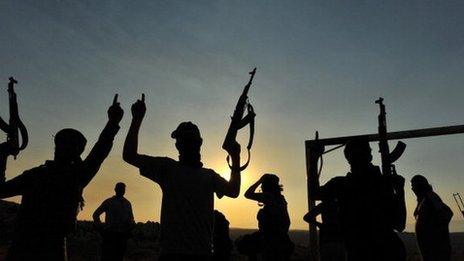
- Published20 June 2014
